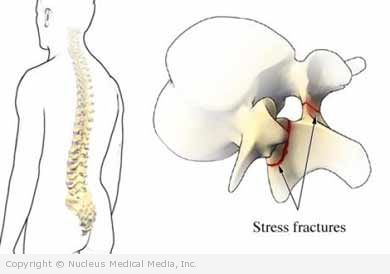Spondylolysis
Spondylolysis – Definition
Spondylolysis is a stress fracture. It occurs in a part of the vertebrae (spinal bone). The pars interarticularis is a portion of the bone between the facets. There is a right and left section.
This condition occurs in the lower back. About 90% of the time it is in the lower back. It can fracture on one or both sides (bilateral). Left untreated, it can lead to spondylolisthesis. This is a more serious condition. The vertebra slips forward on the one below it. Both conditions can cause back pain.
This fracture is the most common cause of back pain in adolescent athletes.
Spondylolysis – Causes
Spondylolysis can be caused by:
- Congenital defect in the spine (usually appears a few years after birth)
- Acute trauma to the back
- Chronic overextension (bending backwards) with or without side bending of the back (common in certain sports and activities)
- Hamstring tightness or muscle imbalance
- Degenerative conditions of the spine
- Cerebral palsy (less common)
Spondylolysis – Risk Factors
Factors that increase the chance of spondylolysis:
- Playing sports (eg, gymnastics, football [especially the offensive line], diving, wrestling, weightlifting)
- Improper athletic or exercise technique
- Adolescent growth spurt
Spondylolysis – Symptoms
Symptoms may include:
- Pain across the lower back
- Spasms in the back and hamstring muscles
- Pain radiating down the leg
- Many people have no symptoms at all.
Spondylolysis – Diagnosis
The doctor will ask about your symptoms and medical history. A physical exam will be done.
Tests may include:
- X-rays — a test that uses radiation to take a picture of the spine to look for defects and/or fractures
- CT scan — a type of x-ray that uses a computer to make pictures of bony structures inside the back
- Single photon emission computed tomography (SPECT) — a type of imaging test that uses gamma rays
- MRI scan — a test that uses a very strong magnetic field and radio waves to make pictures of both soft tissue and bony structures inside the back
Spondylolysis – Treatment
If you have symptoms, treatment may include:
Exercise Restriction
Do not do athletic activities for several weeks to several months. In general, this restriction should last until the symptoms are gone.
Back Brace
Your doctor may suggest that you wear a back brace. This will help relieve pain. About 4-6 weeks of bracing may be needed. The brace should limit extension of the lower (lumbar) spine.
Physical Therapy
To relieve the pain and prevent recurrences, a physical therapist can teach you:
- Exercises to strengthen the back and abdominal muscles — These muscles stabilize the spine.
- Proper exercise and sports techniques to help prevent overuse and further injury
- Hamstring stretches
Medication
The doctor may give you medications for pain relief.
Surgery
Surgery may be needed if there is:
- Injury to the nerve
- High-grade spondylolisthesis (more than 50% slippage)
- No relief from medicine, rest, activity modification, and physical therapy
Two procedures are usually needed:
- Decompressive laminectomy — removal of excess bone and tissue that is putting pressure on the spinal nerves
- Spinal fusion — fusing together of the two involved vertebrae to prevent further slippage of the vertebra
Spondylolysis – Prevention
To reduce your risk of getting spondylolysis:
- Limit how much you participate in certain sports. This will help prevent overuse injury.
- Keep the abdominal and back muscles strong. Keep the hamstring muscles supple.
- Use proper equipment for your sport.
- Warm up properly before exercising or playing sports.
- Learn proper techniques for exercise and athletic activities.
- Seek medical care for chronic back pain. Early vertebral stress fractures, particularly in teens and young adults, may heal with rest.

